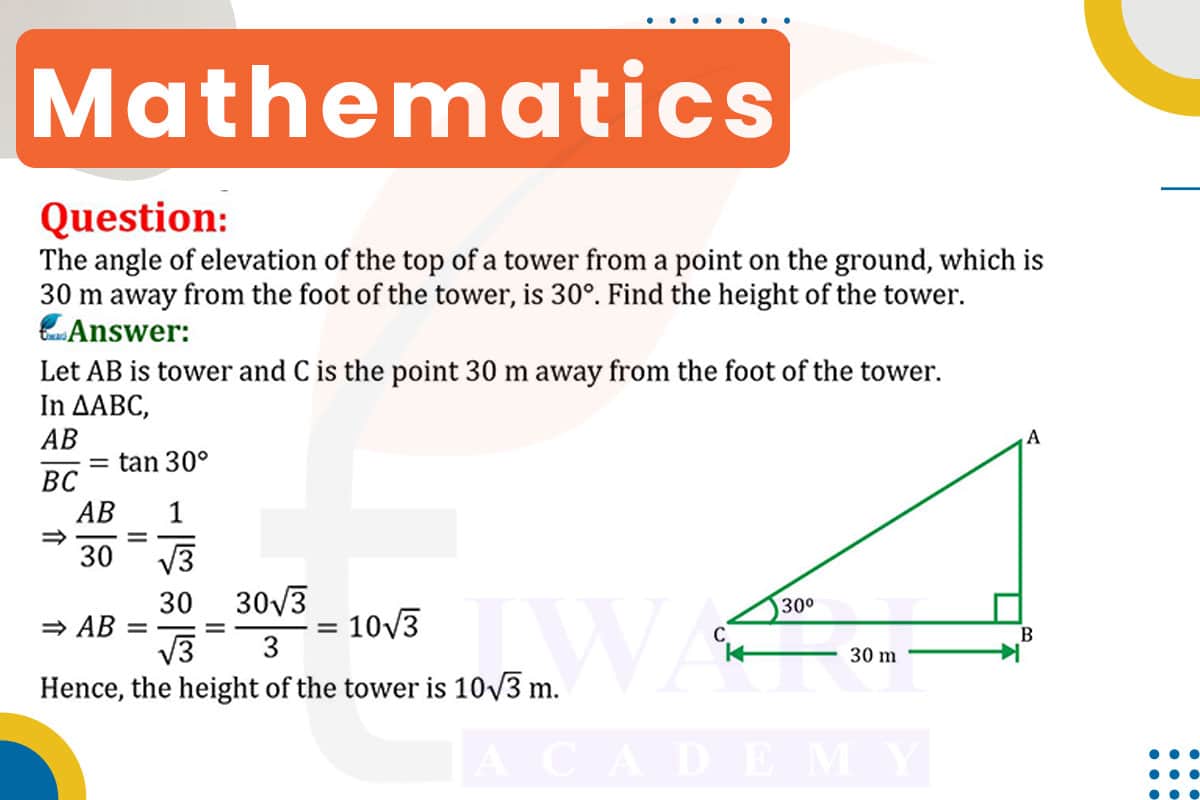To find the height of the tower, we use trigonometry, specifically the tangent function. The tangent of an angle in a right-angled triangle is the ratio of the opposite side (height of the tower) to the adjacent side (distance from the tower).
Given: Distance from the tower = 30 m, Angle of elevation = 30°. The tangent of 30° is 1/√3.
Using the formula tan(30°) = (height of the tower)/(30 m), we have 1/√3 = (height of the tower)/30.
Solving for the height of the tower, we get height of the tower = 30/√3, which simplifies to approximately 17.32 meters. Therefore, the height of the tower is about 17.32 meters.

Let’s discuss in detail
Introduction to Trigonometric Height Measurement
Trigonometry, a branch of mathematics, is extensively used in various fields, including engineering, astronomy, and geography, for measuring heights and distances. One common application is determining the height of inaccessible objects, such as towers, using the principles of trigonometry. The problem at hand involves calculating the height of a tower using the angle of elevation from a certain distance. This scenario is a classic example of a real-world application of trigonometry, demonstrating how mathematical concepts can be practically applied to solve everyday problems.
Measuring a Tower’s Height
The problem involves a tower and a point on the ground 30 meters away from the base of the tower. The angle of elevation from this point to the top of the tower is 30°. The goal is to find the height of the tower. This scenario forms a right-angled triangle with the tower as the opposite side, the distance from the tower as the adjacent side, and the angle of elevation at the point on the ground.
The Role of Tangent in Trigonometry
In trigonometry, the tangent of an angle in a right-angled triangle is the ratio of the length of the opposite side to the length of the adjacent side. In this case, the tangent function is ideal for finding the height of the tower, as we have the angle of elevation (30°) and the distance from the tower (30 meters), and we need to find the height of the tower (opposite side).
Applying the Tangent Function
Applying the tangent function to the 30° angle, we use the formula tan(30°) = (height of the tower)/(distance from the tower). The tangent of 30° is a known value, 1/√3. Substituting the known values into the formula, we get 1/√3 = (height of the tower)/(30 m).
Calculating the Height of the Tower
Solving the equation for the height of the tower, we multiply both sides by 30 meters. This gives us height of the tower = 30 m × 1/√3. Simplifying this equation, we find that the height of the tower is approximately 17.32 meters. This calculation demonstrates how trigonometry can be effectively used to solve problems involving angles and distances in real-world scenarios.
Practical Applications of Trigonometry
This example highlights the practicality of trigonometry in real-life situations. The ability to calculate unknown heights using angles and distances is invaluable in many fields, from construction to navigation. Trigonometry bridges the gap between theoretical mathematics and practical applications, showcasing the importance of mathematical concepts in solving real-world problems. This scenario, in particular, illustrates how trigonometry can provide solutions in situations where direct measurement is not feasible.
Discuss this question in detail or visit to Class 10 Maths Chapter 9 for all questions.
Questions of 10th Maths Exercise 9.1 in Detail


